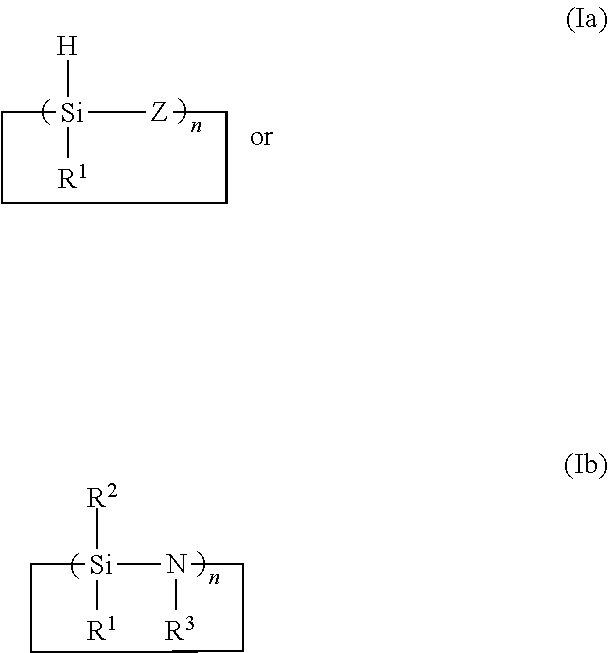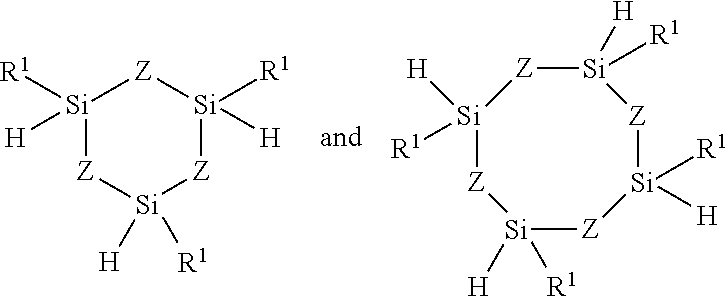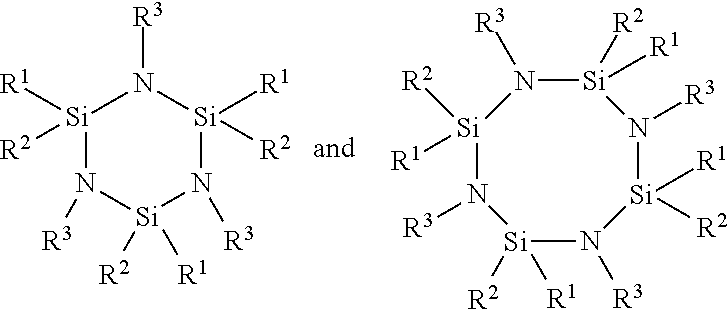Method for making functionalized polymer
a functionalized polymer and polymer technology, applied in the field of functionalized polymer making, can solve the problems of heat loss of energy transmitted to this section of the polymer (and the vulcanizate in which such polymer is incorporated)
- Summary
- Abstract
- Description
- Claims
- Application Information
AI Technical Summary
Benefits of technology
Problems solved by technology
Method used
Image
Examples
examples
[0077]In the examples, dried glass vessels previously sealed with extracted septum liners and perforated crown caps under a positive N2 purge were used for all preparations.
[0078]The following materials were obtained from a laboratory storeroom or synthesized: butadiene solution (in hexane), styrene solution (33.5% in hexane), hexane, n-butyllithium (1.6 M in hexane), 2,2-bis(2′-tetrahydrofuryl)propane (1.6 M solution in hexane, stored over CaH2), butylated hydroxytoluene (BHT) solution in hexane, and 4-dimethylaminophenyl-1,3-dithiane (DMAPDT).
[0079]Commercially available reagents and starting materials included the following, all of which were acquired from Gelest Inc. (Morrisville, Pa.) and used without further purification unless otherwise noted in a specific example: di-t-butylchlorosilane, phenylmethyl-chlorosilane, dimethylaminoethoxysilane, methyldimethoxysilane, methyldiethoxysilane, phenyldiethoxysilane (95% purity), phenylhydrocyclosiloxanes (95% purity, “PHCS”), methylhy...
examples 1-5
[0080]To a N2-purged reactor equipped with a stirrer was added 1.66 kg hexane, 0.45 kg styrene solution, and 2.84 kg butadiene solution (21.1% by wt. in hexane). The reactor was charged with 3.81 mL n-butyllithium, followed by 1.2 mL 2,2-bis(2′-tetrahydrofuryl)propane solution. The reactor jacket was heated to 50° C. and, after ˜34 minutes, the batch temperature peaked at −68° C. This control polymer is identified as sample 1 in Table 1 below.
[0081]After being charged with the same amounts of solvent and reactants, the reactor was charged 3.90 mL n-butyllithium, followed by 1.2 mL 2,2-bis(2′-tetrahydrofuryl)propane solution. The reactor jacket was heated to 50° C. and, after ˜33 minutes, the batch temperature peaked at −68° C. After ˜30 minutes, a 4.12 M solution of 1.6 mL TMCTS in 10 mL hexane was charged to the reactor and stirred at 50° C. for an additional ˜30 minutes. Four portions of the polymer cement were dropped into dried glass bottles. One bottle (sample 2) was set aside ...
examples 6-9
[0084]To a N2-purged reactor equipped with a stirrer was added 1.60 kg hexane, 0.45 kg styrene solution, and 2.89 kg butadiene solution (20.7% by wt. in hexane). The reactor was charged with 3.98 mL n-butyllithium, followed by 1.2 mL 2,2-bis(2′-tetrahydrofuryl)propane solution. The reactor jacket was heated to 50° C. and, after ˜31 minutes, the batch temperature peaked at ˜65° C.
[0085]After an additional 30 minutes at 50° C., portions of the polymer cement were dropped into dried glass bottles. One was terminated with isopropanol (designated sample 6 below), while the other three were reacted with a cyclic siloxane:[0086]sample 7—4.8 M MHCS,[0087]sample 8—2.3 M PHCS, and[0088]sample 9—3.3 M TECTS.
In each of samples 7-9, cyclic siloxane was added so as to provide a 1:1 ratio of initiator-to-siloxane. Each of the bottles were kept in a 50° C. water bath for ˜30 minutes.
[0089]Each of the four polymer cements was dropped separately into isopropanol containing BHT and then drum dried. Th...
PUM
| Property | Measurement | Unit |
|---|---|---|
| temperature | aaaaa | aaaaa |
| temperatures | aaaaa | aaaaa |
| pressure | aaaaa | aaaaa |
Abstract
Description
Claims
Application Information
 Login to View More
Login to View More - R&D
- Intellectual Property
- Life Sciences
- Materials
- Tech Scout
- Unparalleled Data Quality
- Higher Quality Content
- 60% Fewer Hallucinations
Browse by: Latest US Patents, China's latest patents, Technical Efficacy Thesaurus, Application Domain, Technology Topic, Popular Technical Reports.
© 2025 PatSnap. All rights reserved.Legal|Privacy policy|Modern Slavery Act Transparency Statement|Sitemap|About US| Contact US: help@patsnap.com



